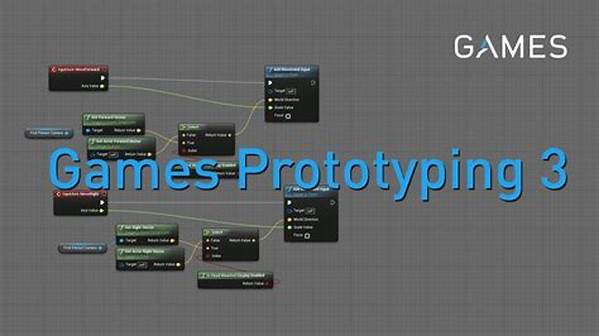Ever wondered how those mind-blowing video game worlds come to life? The answer lies in the magical blend of 3D rendering and game prototyping. Whether you’re a budding game designer or just a curious gamer, understanding these concepts can add a whole new layer of appreciation for the games we all love. So grab your cup of coffee and let’s dive into the world where art meets technology!
Read Now : Learn Game Programming With Online Videos
The Basics of 3D Rendering and Game Prototyping
Imagine constructing a world from scratch—that’s pretty much what 3D rendering is all about. This technique transforms computer-generated models into life-like images that are the building blocks of all visual content in your favorite games. When paired with game prototyping, where developers create a basic version of a game to test key functionalities, these processes form the backbone of game development. In simple terms, think of 3D rendering as sketching out the scenery, while game prototyping is like testing the slides and swings in a playground before opening up to kids. By having a prototype, creators can experiment, tweak, and optimize the gaming experience before going full throttle. This combination allows developers to visualize the world they want to create, making adjustments and improvements along the way for the ultimate virtual escape.
Why 3D Rendering and Game Prototyping Matter
1. Visualization: 3D rendering creates stunning visuals that captivate and inspire players, making the game world believable.
2. Testing: Game prototyping lets developers test ideas quickly, ensuring that concepts are fun and functional.
3. Iterative Improvements: With prototypes, devs can refine mechanics, ensuring seamless gameplay.
4. Team Collaboration: Both 3D rendering and game prototyping foster collaboration among designers, coders, and artists.
5. User Feedback: Early prototypes allow developers to gather player feedback for improvements.
The Art and Science Behind 3D Rendering and Game Prototyping
Art and tech—two seemingly different worlds—come together seamlessly in 3D rendering and game prototyping. These processes require both an artistic eye and technical know-how. Designers must understand lighting, textures, and perspective while also managing algorithms and codes. Think of it as a dance between creativity and computation, where every step needs to be perfectly timed and executed. This blend ensures that each game element is not just visually appealing but also technologically sound. Successful integration results in a product that is both engaging and efficient. It’s fascinating to see how the lines between art and science blur, creating a playground where imagination literally knows no bounds.
Creative Process in 3D Rendering and Game Prototyping
The journey from idea to a playable game involves numerous stages, with 3D rendering and game prototyping being essential components.
1. Conceptualization: Initial ideas are brainstormed and conceptualized.
2. Modeling: 3D rendering begins with creating detailed models of characters and environments.
3. Prototyping: Game prototyping explores the feasibility and playability of game elements.
4. Feedback Loop: Prototypes are tested, allowing for revisions based on user feedback.
Read Now : Open Source Particle Simulation Libraries
5. Refinement: Textures and lighting are polished in the final rendering stage.
6. Integration: Characters and environments are integrated into a coherent gameplay experience.
7. Fine-Tuning: Prototypes are adjusted and refined for optimal performance.
8. QA Testing: Final prototypes undergo rigorous testing to ensure quality.
9. Launch Prep: The finished product is prepped for launch.
10. Release and Updates: Post-launch updates are often driven by 3D rendering adjustments and prototype feedback.
Challenges in 3D Rendering and Game Prototyping
Diving into the world of 3D rendering and game prototyping is not without its challenges. Developers face technological constraints, as rendering requires significant computer power. Balancing high-quality visuals with performance optimization is an ongoing battle. As for game prototyping, the challenge lies in quickly iterating and testing ideas without limitless budgets or timelines. It’s a classic dance of compromise, where the art of tactful balancing shines through. The key is being adaptable, ready to tackle unexpected technical glitches or creative blocks. With innovation at the core, each challenge is a step closer to crafting that gaming masterpiece you ultimately aspire to achieve. So, whether you’re stuck tweaking a shadow or perfecting that jump mechanic, remember that every hurdle is just another piece of the puzzle in the vast playground of digital creation.
The Role of Technology in 3D Rendering and Game Prototyping
Technology is the backbone of 3D rendering and game prototyping. With advancements in software and hardware, designers have more powerful tools at their disposal than ever before. Tools like Blender, Unreal Engine, and Unity allow creators to build games that were once thought impossible. Real-time rendering, AI-driven enhancements, and cloud computing are drastically changing what’s possible in game development. These technologies streamline workflows, allowing for faster experimentation and iteration. However, they also require continuous learning and adaptation from developers. As technology evolves, so do the possibilities for greater realism, more immersive worlds, and groundbreaking gameplay innovations. It’s a thrilling playground where the horizons are continually expanding, pushing the boundaries of what’s possible with 3D rendering and game prototyping.
The Future of 3D Rendering and Game Prototyping
As technology advances, so do the possibilities in 3D rendering and game prototyping. We’re on the brink of creating hyper-realistic game worlds that blur the line between reality and digital. Artificial intelligence will play an increasingly significant role, with machine learning algorithms optimizing everything from rendering techniques to gameplay mechanics. Moreover, the rise of virtual and augmented reality will demand even more sophisticated 3D rendering and dynamic prototyping to deliver fully immersive experiences. Essentially, as gamers’ expectations rise, so will the creativity and innovation in design. The future heralds a new era where digital worlds become canvases for groundbreaking art and cutting-edge tech—transforming how we play, interact, and even how we perceive reality. It’s an exciting time to be part of this progression, whether as a creator or an avid player, where the only limit is truly our imagination.




